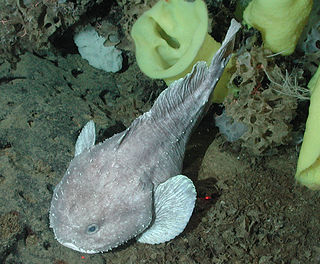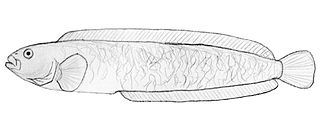
The Cottidae are a family of fish in the superfamily Cottoidea, the sculpins. It is the largest sculpin family, with about 275 species in 70 genera. They are referred to simply as cottids to avoid confusion with sculpins of other families.

The fish family Psychrolutidae contains over 35 recognized species in 8 genera. This family consists of bottom-dwelling marine sculpins shaped like tadpoles, with large heads and bodies that taper back into small, flat tails. The skin is loosely attached and movable, and the layer underneath it is gelatinous. The eyes are placed high on the head, focused forward closer to the tip of the snout. Members of the family generally have large, leaf-like pectoral fins and lack scales, although some species are covered with soft spines. This is important to the species as the depths in which they live are highly pressurized and they are ambush/opportunistic/foraging predators that do not expend energy unless they are forced to.

Pholidae is a family of marine ray-finned fishes, known as gunnels, in the scorpaeniform suborder Zoarcoidei. These are fishes of the littoral zone and are mainly found in North Pacific Ocean, with two species found in the North Atlantic Ocean and Arctic Ocean.

Ernogrammus is a genus of marine ray-finned fishes belonging to the family Stichaeidae, the pricklebacks or shannies. These fishes are found in the North Pacific Ocean.

Rathbunella is a genus of marine ray-finned fishes belonging to the family Bathymasteridae, the ronquils. These fishes are found in the eastern Pacific Ocean.

Stichaeinae is a subfamily of marine ray-finned fishes, classified within the family Stichaeidae, the pricklebacks or shannies. These fishes are found in the North Pacific, Arctic and North Atlantic Oceans.

The fourline snakeblenny is a species of marine ray-finned fish belonging to the family Stichaeidae, the pricklebacks and shannies. It is the only species in the monotypic genus Eumesogrammus. This fish is found in the Western North Atlantic, Arctic and North Pacific Oceans.
The crisscross prickleback is a species of marine ray-finned fish belonging to the family Stichaeidae, the pricklebacks and shannies. It is the only species in the monotypic genus Plagiogrammus. This fish is found in the eastern Pacific Ocean off California.
The radiated shanny is a species of marine ray-finned fish belonging to the family Stichaeidae, the pricklebacks and shannies. It is the only species in the monotypic genus Ulvaria. This fish is found in the northwestern Atlantic Ocean.

Stichaeus is a genus of marine ray-finned fishes belonging to the family Stichaeidae, the pricklebacks or shannies. These fishes are mainly found in the North Pacific Ocean with one species in the Arctic and western North Atlantic Oceans.
Stichaeopsis is a genus of marine ray-finned fishes belonging to the family Stichaeidae, the pricklebacks or shannies. These fishes are found in the western North Pacific Ocean.

Opisthocentrinae is a subfamily of marine ray-finned fishes, classified within the family Stichaeidae, the pricklebacks or shannies. These fishes are found in the North Pacific Ocean.
Askoldia is a monotypic genus of marine ray-finned fishes belonging to the family Stichaeidae, the pricklebacks and shannies. Its only species is Askoldia variegata which is found in the northwestern Pacific Ocean.

Kasatkia is a genus of marine ray-finned fishes belonging to the family Stichaeidae, the pricklebacks or shannies. These fishes are found in the North Pacific Ocean.
Lumpenopsis is a genus of marine ray-finned fishes belonging to the family Stichaeidae, the pricklebacks or shannies. These fishes are found in the North Pacific Ocean.

Opisthocentrus is a genus of marine ray-finned fishes belonging to the family Stichaeidae, the pricklebacks or shannies. These fishes are found in the North Pacific Ocean.

Pholidapus is a monotypic genus of marine ray-finned fishes belonging to the family Stichaeidae, the pricklebacks and shannies. Its only species is Pholidapus dybowskii which is found in the northwestern Pacific Ocean.
Lumpeninae is a subfamily of marine ray-finned fishes, classified within the family Stichaeidae, the pricklebacks or shannies. These fishes are found in the North Pacific, Arctic and North Atlantic Oceans.
Xiphisterinae is a subfamily of marine ray-finned fishes, classified within the family Stichaeidae, the pricklebacks or shannies. These fishes are found in the North Pacific Ocean.

Cottinae is a subfamily of ray-finned fishes belonging to the family Cottidae, the typical sculpins. The subfamily has species throughout the northern hemisphere in both marine and freshwater habitats.












